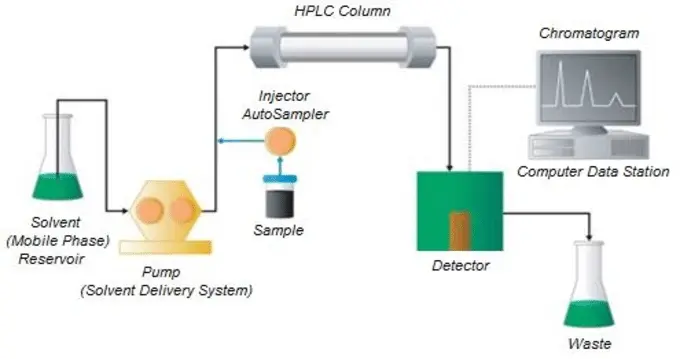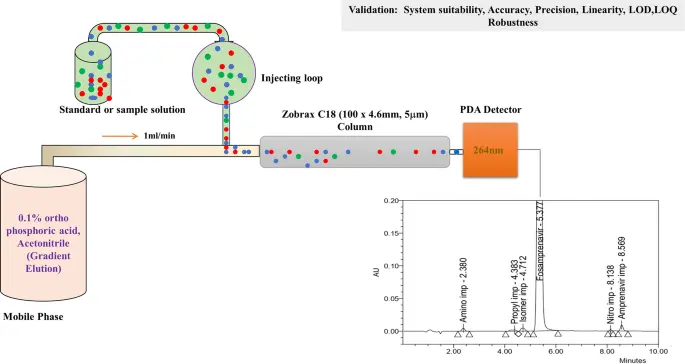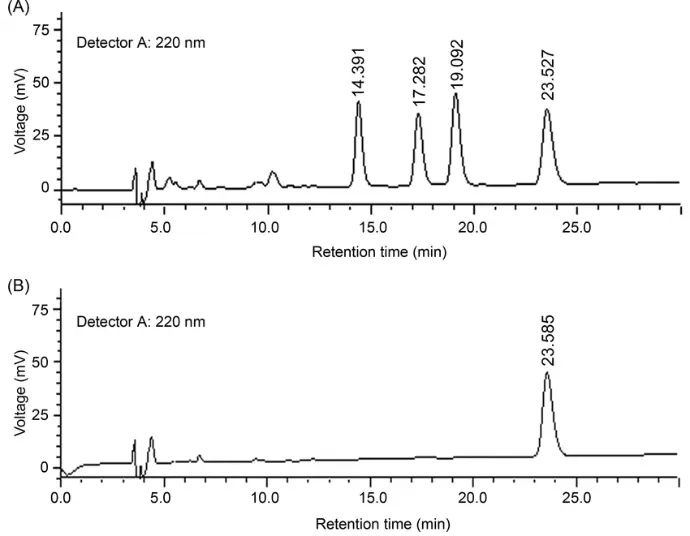Introduction
High-Performance Liquid Chromatography (HPLC) is one of the most trusted and widely used methods in laboratories today. It is designed to separate, detect, and measure different substances in a mixture with high accuracy and speed.
HPLC is essential in areas such as biotechnology, pharmaceutical development, food safety, and environmental testing. It plays a critical role in product quality control, research, and routine testing.
What is HPLC and How Does It Work?
HPLC works by passing a liquid sample through a tube (called a column) filled with a special material. As the liquid moves, the different substances inside the sample move at different speeds — and that allows them to be separated.
Each substance is detected and measured as it comes out of the column. The time it takes to come out is called the retention time.
Main parts of an HPLC system:
Liquid container (solvent reservoir) holds the clean liquid (mobile phase)
Pump pushes the liquid through the system at high speed
Injector where the sample is added
Column the main area where the separation happens
Detector identifies and measures each substance
Types of HPLC Methods
HPLC systems can be customized depending on the nature of the sample and the objective of the analysis. Here are the five most commonly used HPLC techniques, each with its own strengths and use cases.
Reverse Phase HPLC (RP-HPLC)
Reverse Phase HPLC is the most widely used method in laboratories. It uses a non-polar stationary phase (such as C18 or C8 bonded silica) and a polar mobile phase, typically a mixture of water and organic solvents like methanol or acetonitrile.
How It Works:
Non-polar molecules are retained longer in the column due to their attraction to the non-polar stationary phase. More polar molecules elute faster. By adjusting the ratio of water to organic solvent, scientists can fine-tune how long each substance stays in the column.
Common Applications:
Protein and peptide analysis
Hormones and metabolic products
Plant extracts and bioactives
Normal Phase HPLC (NP-HPLC)
Normal Phase HPLC is the original form of liquid chromatography. It uses a polar stationary phase (such as bare silica) and a non-polar mobile phase, like hexane or chloroform.
How It Works:
Polar compounds interact strongly with the stationary phase and are retained longer, while non-polar compounds elute more quickly.
Common Applications:
Separation of natural products
Fatty acid analysis
Purification of isomers
Organic compound profiling
Ion Exchange HPLC (IEX-HPLC)
Ion Exchange HPLC is designed for separating charged molecules by exploiting their attraction to oppositely charged groups in the stationary phase.
Cation exchange retains positively charged substances.
Anion exchange retains negatively charged substances.
How It Works:
Samples are loaded under low-salt conditions and eluted by gradually increasing the salt concentration. The more strongly a molecule binds to the column, the later it elutes.
Common Applications:
Separation of nucleotides, DNA, and RNA
Analysis of amino acids and proteins
Quality control of monoclonal antibodies
Isoform profiling
Size Exclusion HPLC (SEC or GFC):
Size Exclusion Chromatography (SEC), also known as Gel Filtration Chromatography (GFC), separates molecules based on their size rather than their chemical properties.
How It Works:
The stationary phase consists of porous beads. Larger molecules cannot enter the pores and elute quickly. Smaller molecules enter the pores and take longer to pass through the column.
Common Applications:
Protein and antibody purification
Detection of protein aggregates
Polymer size distribution
Chiral HPLC
Chiral HPLC is used to separate enantiomers, which are molecules that are mirror images of each other but may behave very differently in biological systems.
How It Works:
Chiral stationary phases contain special molecules that can distinguish between left-handed and right-handed enantiomers. These phases interact differently with each form, allowing them to be separated and measured.
Common Applications:
Analysis of chiral drug substances
Enantiomeric purity testing
Quality control in pharmaceutical production
Regulatory compliance for chirality
Why is HPLC Important in Biotechnology?
In biotechnology, precision and consistency are everything. High-Performance Liquid Chromatography (HPLC) plays a critical role in the development, monitoring, and quality control of biomolecules and biologically derived products. From early-stage research to full-scale production, HPLC provides the high-resolution analysis required to meet scientific, clinical, and regulatory standards.
Whether you're working with proteins, peptides, plasmids, or gene therapy products, HPLC is a cornerstone technique for ensuring product integrity and performance.
Benefits of Using HPLC
HPLC is popular because it offers several strong advantages for labs and production teams:
✅ High accuracy gives reliable and repeatable results
✅ Speed fast testing and separation
✅ Sensitivity detects even very small amounts of a substance
✅ Flexibility works with a wide range of samples
✅ Consistency useful for routine checks and long-term monitoring
How to Choose the Right HPLC Products
Choosing the right supplies is essential for getting the best results:
✅ HPLC-grade solvents: Clean liquids with no impurities
✅ Reliable columns: Choose by size, material, and goal
✅ Standards and controls: Ensure your system is calibrated correctly
✅ HPLC kits: Complete, ready-to-use solutions for specific tests
High-Performance Liquid Chromatography is one of the most important techniques in modern laboratory work. Whether you are in research, product development, or quality control, HPLC helps deliver precise, repeatable, and fast results.


